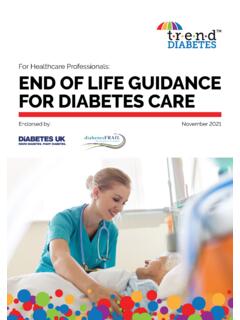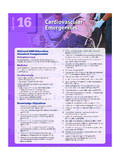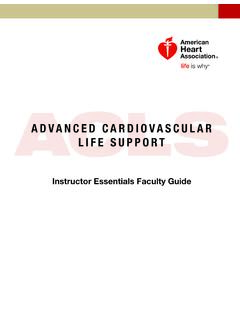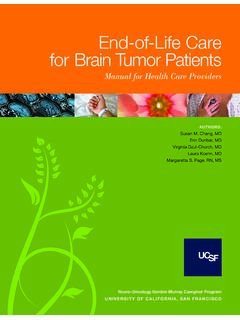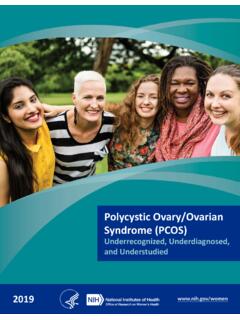Transcription of Module # 7: Comprehensive Geriatric Assessment
1 Module # 7: Comprehensive Geriatric Assessment Geriatrics, Palliative Care and Interprofessional Teamwork Curriculum Module # 7: Comprehensive Geriatric Assessment James J. Peters VA Bronx Medical Center Geriatric Research, Education & Clinical Center Mount Sinai School of Medicine Brookdale Department of Geriatrics and Adult Development This interdisciplinary curriculum is geared to allied health students and may be reproduced and used with attribution. Geriatrics, Palliative Care and Interprofessional Teamwork Curriculum Module # 7: Comprehensive Geriatric Assessment Table of Contents Page(s) I. Overview 1 II. Learning Objectives 1 III. Inpatient Comprehensive Geriatric Assessment 2-10 VISN 3 Geriatric Research, Education & Clinical Center (GRECC) Geriatrics, Palliative Care & Interprofessional Teamwork Curriculum Module # 7: Comprehensive Geriatric Assessment Geriatrics, Palliative Care and Interprofessional Teamwork Curriculum Module # 7: Comprehensive Geriatric Assessment I.
2 Overview As patients age, functional impairments (cognitive, physical, psychological and social) can have a profound effect on their ability to maintain their health and to live independently in the community. Many of these impairments can be treated simply and inexpensively if they are identified early. Others require more extensive evaluation and management. In the outpatient setting, the Comprehensive Geriatric Assessment is an important tool that can identify a broad range of these functional impairments and their interaction with patients underlying medical problems, home environments and social support systems, allowing for early intervention and treatment. In the inpatient setting, the elderly face an additional set of challenges often termed the hazards of hospitalization that include prolonged bed rest, tethering, functional incontinence, unfamiliar environments, falls, and pressure ulcers.
3 These can lead to further functional decline, worsening of chronic illnesses and poor response to treatment for patients presenting medical problems. The Comprehensive Geriatric Assessment is an important tool for addressing the full spectrum of issues confronting hospitalized older patients with the ultimate goals of treating acute illnesses while maintaining function, and return to independent living in the community. Ideally, an interdisciplinary geriatrics team is available to perform the CGA. A physician, nurse practitioner or physician s assistant needs to perform the medical history and physical exam components of the CGA. The remainder of the CGA s domains can be assessed by other members of the team. II. Learning Objectives 1. Briefly describe the goals and domains of a functional Geriatric Assessment . 2. Know when and where a general Geriatric Assessment should be conducted 3.
4 Understand the risk posed to elderly patients by the hazards of hospitalization . 1 VISN 3 Geriatric Research, Education & Clinical Center (GRECC) Geriatrics, Palliative Care & Interprofessional Teamwork Curriculum Module # 7: Comprehensive Geriatric Assessment III. Inpatient Comprehensive Geriatric Assessment The current CGA used on the inpatient service at the Bronx VA assesses 18 different areas of function. The outpatient CGA assesses 17. (Delirium is omitted.) The following is an annotated outline of the inpatient CGA based on the Geriatrics Review Syllabus, Sixth Edition and 2006-2007 Geriatrics at your Fingertips. A. Delirium is the most common hazard of hospitalization in older adults, and is defined as an acute disorder of attention and cognition. 1. Frequently under-recognized in the hospitalized patient a) Missed more often by physicians than by nurse b) Requires formal Assessment Confusion Assessment Method (CAM) A.
5 Can lead to poor clinical outcomes a) Increased risk of death b) Prolonged hospital stay c) Nursing home placement d) Poor functional recovery B. Risk factors for developing delirium a) Dementia b) advanced age c) Sleep deprivation d) Immobility e) Dehydration f) Pain g) Sensory deficit C. Causes of delirium many are reversible or treatable a) Medications b) Infections c) Metabolic abnormalities d) cardiovascular problems e) Neurological problems f) Fecal impaction g) Urinary retention h) Postoperative state i) Sleep deprivation B. Dementia: Memory impairment combined with sufficient loss of other cognitive function to interfere with daily living. 1. Can lead to: a) Loss of independence b) Care giving expenses c) Falls d) Accidents 2 VISN 3 Geriatric Research, Education & Clinical Center (GRECC) Geriatrics, Palliative Care & Interprofessional Teamwork Curriculum Module # 7: Comprehensive Geriatric Assessment e) Delirium f) Difficulty following medical regimen g) Death 2.
6 Prevalence increases with age 3. Most (60-70%) dementias in the US are due to Alzheimer s Disease 4. A small percentage of dementias have a reversible cause a) Vitamin B12 deficiency b. Thyroid disease c) Depression d) Neuro-syphilis 5. Both history from family or caregivers, and formal Assessment essential for diagnosis a) Mini-Cog (Clock drawing test and three item recall) b) Mini Mental State Exam (MMSE) c) Animal naming test d) Formal neuro-psych testing e) Early treatment can improve quality of life and maximize function while allowing patient and family establish goals of care and plan for the future C. Depression 1) Major Depression, while somewhat less frequent among the elderly than among the middle-aged, is under diagnosed. 2) Depressive symptoms that do not meet DSM-IV criteria for Major Depression are common among the elderly.
7 3) Presenting symptoms are more frequently anhedonia and somatic complaints such as lack of energy, which patients may fail to mention to health care providers thinking they are just part of older age. 4) Untreated Major Depression or depressive symptoms can lead to a) Worsening of underlying medical illness, especially cardiac disease b) Loss of physical function c) Pseudo-dementia d) Suicide e) Death 5) It is important to screen elderly patients for depression using a standardized instrument such as the Geriatric Depression Scale (GDS) which comes in 5, 15 and 30 question versions and the Patient Health Questionnaire (PHQ-9) 3 VISN 3 Geriatric Research, Education & Clinical Center (GRECC) Geriatrics, Palliative Care & Interprofessional Teamwork Curriculum Module # 7: Comprehensive Geriatric Assessment D.
8 Gait and Balance 1) A variety of factors contribute to gait and balance abnormalities as patients age a) Decreased muscle mass and strength b) Injuries c) Arthritis d) Neuropathies e) Neurologic illness f) Sensory deficits i. Visual ii. Proprioceptive iii. Vestibular g) Medications 2) Alterations in gait and balance can lead to falls 3) There are effective interventions to improve gait and balance a) Physical therapy b) Occupational therapy c) Assistive devices d) Treatment of underlying medical illness e) Adjustment of medications 4) It is important to screen elderly patients for gait and balance problems using a standardized instrument such as the Performance-Oriented Mobility Assessment (POMA) E. Falls 1) Can lead to significant morbidity and loss of independence 2) Etiology is multi-factorial a) Intrinsic i. Poor balance ii. Weakness iii. Gait abnormalities iv.
9 Chronic illness v. Dementia vi. Sensory Deficits b) Extrinsic Poly-pharmacy c) Environmental i. Clutter ii. Rugs iii. Poor lighting iv. Uneven surfaces 4 VISN 3 Geriatric Research, Education & Clinical Center (GRECC) Geriatrics, Palliative Care & Interprofessional Teamwork Curriculum Module # 7: Comprehensive Geriatric Assessment v. Lack of appropriate safety devices such as grab bars in the bathroom 3) It is important to take a careful history of falls over the last year, and to screen for risk factors. F. Hearing 1) Hearing loss is common as people age. 2) Screening can be performed with a whisper test. 3) Hearing loss can lead to a) Social isolation b) Decreased mobility c) Loss of self esteem d) Anger e) Difficulties in participating in medical encounters f) Decreased quality of life 4) There are effective methods to improve hearing and communication a) Hearing aids b) Personal amplification devices c) Adaptive equipment d) Communication Enhancement Strategies G.
10 Vision 1) Visual impairment is common as patients age 2) Visual impairment can lead to a) Falls b) Motor vehicle accidents c) Decrease quality of life d) Decreased ability to perform ADLs and IADLs e) Decreased functional independence 3) Some causes of visual impairment are easily and effectively treated a) Refractive error b) Cataracts 4) Others require more extensive work-up and treatment a) Glaucoma b) Macular degeneration c) Diabetic retinopathy 5) All benefit from early identification and intervention. 5 VISN 3 Geriatric Research, Education & Clinical Center (GRECC) Geriatrics, Palliative Care & Interprofessional Teamwork Curriculum Module # 7: Comprehensive Geriatric Assessment 6) Screening with a Snellen chart is quick and easy. 7) All elderly patients should have yearly ophthalmologic screening for glaucoma.

